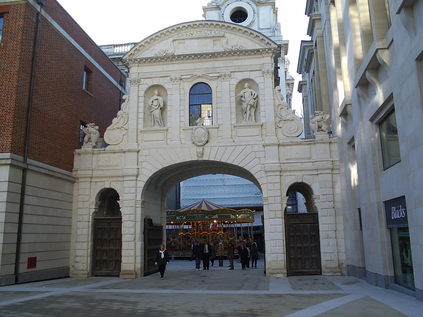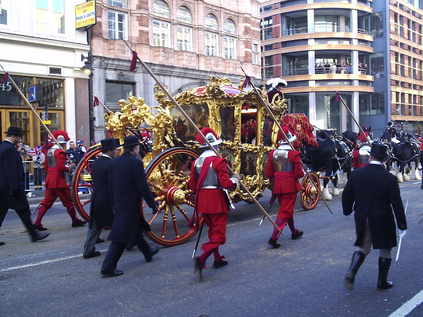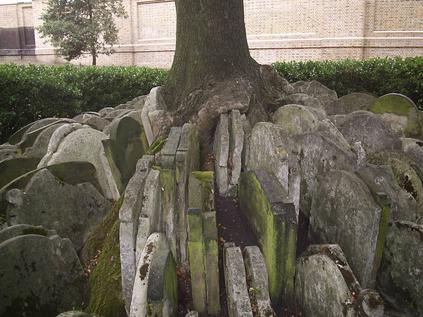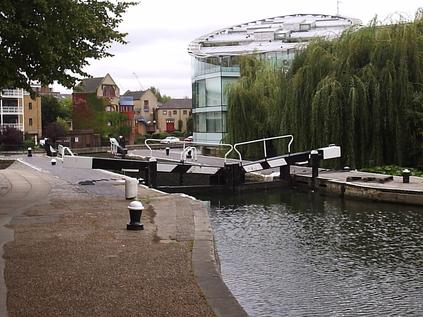To celebrate the 150th anniversary of the beginnings of The London & Middlesex Archaeological Society there are many special events planned - today was the first of a series of 'Central London Walks', this time visiting London Squares. Started early from Weston, with a cool and misty journey diverted via the Berks & Hants route. First to Waterloo Bridge for coffee and breakfast. Met the other walkers on the River Terrace at Somerset House. The walk started in now powerful sunshine, and headed north over Aldwych and the site of Saxon Lundenwic, to Covent Garden. The arcade, part of the extension to the Royal Opera House gives an idea of how the square looked when first built. From here to Inigo Jones curious St. Paul's church with its decorative but ultimately pointless east elevation. West again now, to Leicester Square.
It is this part of the walk I dreaded. I'm not a fan of the gaudy, crowded precincts of the West End of London. A lot has changed however since I last visited. Here Jon Finney, our guide spoke a little about the responsibility of those who conserve or preserve sites, and how doing so can change the nature of a place. Indeed Leicester Square seemed more spacious, personable and open than before. We proceeded to Trafalgar Square via the rather silly Sainsbury Wing of the National Gallery, and I was impressed again by change. Gone is the impossible circuit of traffic, and a wide open prospect down to Whitehall gives fine views. The square is accessible and usable, but as our guide points out - is no longer a square!
Under Admiralty Arch next, along the Mall and past the Nash terraces - seemingly built of pink blancmange. Nash buildings always make more sense to me from a distance, and at close quarters lack any interest at all. Up the steps beside the ICA (and the mysterious doorway which haunts Subterranea Britannica), and to St. James' Square - London's first and at one point most exclusive residential square. Built as a speculative venture, it became a haunt of Dukes and Earls. No residences or indeed original buildings now surround the square. The walk ended at Burlington House - home of the Royal Academy, where a remodelled courtyard works less well. A chance to look around restored William Kent rooms before heading off into the midday sunshine.
This walk took me to areas I tend to avoid - my interest and knowledge of London lies east of here. Decided to capitalise on the opportunity and visit one or two sites which I would normally not get near. Started with a sweep through St. James' Park to Parliament Square, something I did on my first solo visit to London many years ago. Impossibly crowded, so I decided to seek out Westminster Cathedral. I'd been reading about the Cathedral recently, and the failing health of Pope John Paul II had ensured it being featured on televison recently as a backdrop to ecclesiastical vox pops. Problem was, I couldn't find it! It seems not to feature on any map of the area at all. Struck out along Victoria Street, eventually finding a direction sign - soon enough the oddly octagonal, red brick byzantine influenced tower appeared over the rooftops.
On turning into the piazza around Bentley's amazing building I was struck by the odd atmosphere. Satellite broadcasting vans everywhere, cables running to expectant cameras and off-duty newscasters lounging on bollards. People were visibly waiting for the Pope's passing. The only person really doing anything in that strangely quiet square was a Big Issue seller, proclaiming his wares from the Cathedral steps. On a strange whim, went inside. The interior was wonderful. Eric Gill's stations of the cross adorn marbled pillars, whilst overhead is blank brickwork. The usual conspicuously rich iconography of a Catholic place of worship looks less out of place here than in older churches. A small altar with a picture of the pontiff had been set up, and a continuous stream of the faithful visited it, lit a candle and moved on. The Cathedral was filling slowly and silently with people. At one point, a Cathedral official approached a microphone and called for attention - the expectation was palpable. He gave a message for someone to meet their daughter at the main doors, nothing more. An entire congregation let out a sigh of relief. Some in fact, fell to their knees. I sat for quite a while mesmerised by the atmosphere, but eventually felt extremely out of place.
Fled to more certain ground, and found myself pounding my usual beat of Blackfriars, Newgate, Smithfield and Clerkenwell before heading back to Paddington and a quiet journey home. A strange day where I challenged my prejudices in many ways.

Wrapped up in Books and Ecumenical Matters
Posted in London on Saturday 20th November 2004 at 11:09pm
Another early start, and coincidentally another trip to London with 'Sulis Minerva' at the rear of the 0640. Engineering on the Circle means H&C to Barbican and time for breakfast before heading to the Museum of London for the 39th London & Middlesex Archaeological Society Local History Conference. This years theme being "1400 Years of St. Paul's Cathedral and the Diocese of London".
Excellent attendence, with me possibly one of the younger members of the audience! The speakers covered a range of viewpoints and disciplines. We started with the Bishop of London, Richard Chartres who gave an entertaining overview of the Missionary Work in Victorian Times - often amusing and very well informed.
Other personal highlights were an account of Anglicanism in 18th century London and the many new City Churches which were built, and Dr John Schofield's talk on Old St. Pauls, which remains an object of fascination to me. We were also extremely lucky to have Martin Stancliffe, Surveyor of the Fabric of St. Pauls to talk about the secrets which the current building continues to reveal.
Professor James Raven's talk on the book trade in the precinct of St. Pauls was doubly rewarding. Apart from describing the history of the now long-disappeared Paternoster Row he gave an enthralling account of the historical methods he had used to piece together the changing ownership and usage of the individual establishments involved in the book trade in the area. Had a pleasant if expensive lunch in the Museum cafe and then browsed the bookshop and stalls which many of the Local History Societies from surrounding areas had set up.
Out into the cold damp evening, and decided to head for the pub before travelling back to Paddington, and catching the 1845 home. All well until Reading, where the train moved off before the doors were closed or secured. Chaos ensued. First Great Western staff milling around everywhere, the Train Manager getting increasingly stressed and becoming dangerous flippant and rude to customers, and general confusion. Eventually, they decided to terminate the train. Problem is, whilst we had waited several trainloads of rugby fans had arrived from Twickenham and swelled our ranks.
Managed to get a seat on the next, very wedged Bristol-bound service. Pretty unpleasant atmosphere with lots of angry people in a confined space. Not a pleasant journey. Loaded into a taxi at Temple Meads, along with an acquaitance I only ever seem to meet on the train or at strange and difficult moments! Pleasant, if slightly alarming taxi ride back to Weston. An unusual end to an exhausting but informative day...
Woke early to a freezing but clear morning. Out on the 0640 with pet power car 43130 'Sulis Minerva' behind us. Sun came up somewhere along the way, and it seemed like a dry and bright day was in store. Perfect weather for the planned events!
Directly onto a delayed Circle Line and to Blackfriars for coffee. Watched the City getting ready for showtime for a while, then headed to Paternoster Square to see Temple Bar, newly restored to London after 130 years in Theobald's Park. Got some pictures before things became too busy.

The completed development at Paternoster Square is an improvement on previous efforts in the area. The large public space also contains a pillar representing one designed by Inigo Jones for Old St. Pauls which is in fact a ventilation shaft for the New Stock Exchange underground parking.
Assumed my spot on Ludgate Hill for the Show. Very chilly. I attempted to help some Spanish tourists to understand what was happening, and they stayed to see the whole procession - even the 'Gibraltar British Anniversary' float which they accepted with some discomfort but good grace! As ever, a strange mix of military bands, financiers on rollerskates, many Mini Coopers, community project floats and pageantry of ancient significance.

I enjoyed events a great deal - certainly more than last year when I wasn't feeling up to par, and was concious of others' disappointment for much of the time. Even a family more intent on sharing out their extensive picnic despite fingers too cold to open the packages couldn't dampen my enthusiasm. Highlights as ever were the Livery Companies and the passing of the new Lord Mayor himself on the way to swear an oath at the Royal Courts of Justice.

After the show had passed, had a cold and rather forlorn lunch break in Abchurch Yard before heading south to visit the George Inn - a fine old galleried inn which remains a pub today. The inn was beloved of William Kent who wrote a small pamphlet on its history. Amazing to find such a strange anachronism a step off the unrelentingly busy Borough High Street. One to visit again soon.
Back over London Bridge to briefly visit St. Stephen Walbrook and watch the tail end of the returning parade arriving at Mansion House. Then over to 1 Poultry to join a City of London walk organised by the Corporation. Very popular, with large groups setting off every few minutes. Our guide was friendly and knowledgeable, if a little overawed at such a large group. We made a quick sweep through the city via the fine Adam houses in Frederick's Place, the Guildhall, Cheapside, St. Paul's, Old Bailey and Blackfriars. Thoroughly enjoyed the walk, which touched on many things I'd discovered myself. It's always good to have things confirmed and to hear a new perspective on the City.
From Blackfriars, got more much needed hot coffee and headed onto Victoria Embankment. Soon after the Lord Mayor's car sped by, and the incredible firework display was underway. Fifteen minutes of the most impressive pyrotechnics I've seen in a long time. Huge crowds too. Decided to head north to avoid the departing audience, via Smithfield to Farringdon and thence Paddington.
Since the restaurant I'd hoped to visit was busy, searched for an alternative and found frankly very little. Settled for a small Indian place which led to perhaps the oddest culinary experience of my life! I have to say the food was fine, sensible portions of tasty food at (by London standards) reasonable prices. The bathroom however was in a flooded basement, which by all accounts had been underwater for some time. On paying I was told that the credit card machine was "out of use". Having no cash I was invited to accompany the waiter to a nearby ATM. I paid him in the street with much handshaking and apologising for the inconvenience. Very odd evening.
Steadied my nerves with a pint of Adnams Broadside in the Dickens Tavern. Noted with some dismay a bunch of American tourists who'd been in for food and beer taking pictures of the pub. I can only hope it was for a "this is where we ate" conversation and not because they thought that Charles Dickens had anything to do with a place he patently didn't. Sleepily returned to Paddington for a quiet journey home in First Class.
Up early after a refreshing night of sleep. Checked out of the hotel, and enjoyed my customary replacement breakfast on Southampton Row. Had planned two objectives for today.
The first was to visit St. Pancras Old Church. This is where the young Thomas Hardy was charged with the task of disinterring and reburying the dead in conjunction with the construction of the Midland Railway. Strangely, the works for the Channel Tunnel Rail Link are now on the same site, and its easy to imagine Hardy at work here. He is commemorated by a tree, surrounded by some of the tombstones moved to accomodate the railway.

Spent quite a bit of time at the church, stumbling across the monument to William Godwin and Mary Wollstonecraft, and the Soane family tomb, which reputedly inspired the design of the old red Telephone Box.
Leaving the churchyard, I plunged headlong into the mess of work sites for the Channel Tunnel Rail Link, and found myself picking my way along the authorised walking route between deep pits, flooded gullys and streams of competing, diverted traffic. I still fear that the quite amazing station building at St. Pancras will be wrecked by all this work. Finally struggled out somewhere near Kings Cross and struck out east for my next objective.
On Pentonville Road and City Road, I realised I was again walking the boundary - a narrow band between the end of the City and the beginning of the suburbs. A place where people are trying hard to get in or out, but rarely want to stay in the same spot. Everything seems to come to a head at the Angel, where suburban Islington meets the edge of the City in a mess of traffic and wine bars. A relief then to swing north onto Colebrook Row (once the home of Charles and Mary Lamb) in search of the Regent's Canal. Wandered along the pleasant, quiet, almost rural row of cottages built along what was once Myddleton's 'New River', and which is now a long narrow stretch of parkland. Quite accidentally stumbled across the eastern mouth of Islington Tunnel.
The canal is an oasis. Calm, quiet and soothing (despite the appeal for witnesses to Actual Bodily Harm on the tow path gates). Walked as far as the lock at the entrance to City Road Basin.

The canal is also a boundary in itself, forming an arc around the northern fringe of the city, from Paddington to Limehouse. An impressive achievement overall. Eventually turned back towards City Road. From here, crossed into the strange boundary lands once more, pressing along Spencer Street (full of students registering at City University) and Myddleton Street - home of the Family Records Centre, into Exmouth Market. Settled down with coffee and watched the always busy street for awhile.
So, walk over I headed for Farringdon and then to Paddington. When I surfaced from the underground, it had begun to rain and all was rather grey and dull. A very pleasant, tiring and oddly challenging weekend. Time to start planning for next time.
Lost::MikeGTN
I've had a home on the web for more years than I care to remember, and a few kind souls persuade me it's worth persisting with keeping it updated. This current incarnation of the site is centred around the blog posts which began back in 1999 as 'the daylog' and continued through my travels and tribulations during the following years.
I don't get out and about nearly as much these days, but I do try to record significant events and trips for posterity. You may also have arrived here by following the trail to my former music blog Songs Heard On Fast Trains. That content is preserved here too.



